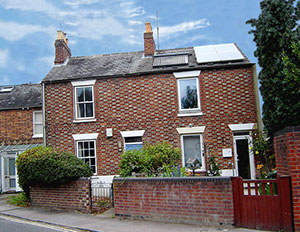Wandering along Nelson Street in Oxford’s Jericho area, the solar panels on the roof of one pretty brick terraced house may catch your eye glinting in the sun.
Of course, solar panels like these are nothing new and can be seen on homes up and down the UK. What you can’t see, though, are the hidden improvements to the fabric of the whole house to create the most energy efficient and low carbon retrofit in Oxfordshire.
Rajat Gupta, Professor of Architecture and Climate Change at Oxford Brookes, is in charge of a two-year project to monitor the performance of this refurbished house which uses 85% less gas and electricity when compared to conventional homes.
Rajat and his research associate, Matt Gregg, will receive real-time information on the houses’s temperature, humidity and carbon dioxide levels and will find out how the householders change their behaviour and energy consumption thanks to a state-of-the-art monitoring system fitted throughout their home.
Aside from slashing gas and electricity bills from £600 a year to £150, the house is comfortable, healthy and produces 80% less CO2 emissions than conventional homes.
The Government has imposed tough long-term targets for greenhouse gases and by 2050 they want to cut emissions in the UK by 80%.
The Nelson Street house is a £150,000 research project funded by the Government’s Technology Strategy Board Retrofit for the Future programme to find out how such targets could be achieved from our homes. All the materials and building techniques are available right now but very few houses are retrofitted to such high standards.

